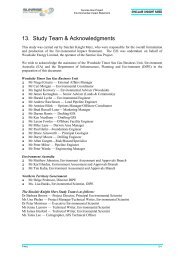Appendix D Terrestrial and Aquatic Biodiversity - Environment ...
Appendix D Terrestrial and Aquatic Biodiversity - Environment ...
Appendix D Terrestrial and Aquatic Biodiversity - Environment ...
Create successful ePaper yourself
Turn your PDF publications into a flip-book with our unique Google optimized e-Paper software.
5.3 Vegetation Surveys<br />
National Vegetation Information System (NVIS) data has been applied across the entire project area (mining<br />
area, haul road route <strong>and</strong> port facility). Vegetation types are described at NVIS level 3 providing detail on<br />
growth form, height <strong>and</strong> cover of characteristic species in the dominant stratum (Hnatiuk, et al.<br />
2009). Detailed information including dominant species in the upper <strong>and</strong> ground stratums <strong>and</strong> general<br />
l<strong>and</strong>form features are provided in Table 15.<br />
The vegetation map presented in Figure 27 <strong>and</strong> Figure 28 has identified that the haul road route is set to<br />
traverse large sections of Eucalyptus woodl<strong>and</strong> located on flat to undulating plains (Veg ID 570) located east<br />
of the Limmen Bight River <strong>and</strong> continuing through to the Bing Bong port facility. This vegetation type is<br />
dominated by Eucalyptus tetrodonta, Corymbia ferruginea <strong>and</strong> Erythrophleum chlorostachys in the upper<br />
stratum. Intersected by this section of the haul road are also a number of small isolated patches of<br />
Melaleuca nervosa & M. viridiflora woodl<strong>and</strong> (Veg ID 321) on the drainage flats. An area of low floodplain is<br />
also located along the southern section of Rosie Creek, supporting a Chrysopogon (mixed) low tussock<br />
grassl<strong>and</strong> (Veg ID 336) dominated by Eucalyptus microtheca +/- Terminalia platyphylla +/- Ventilago<br />
viminalis. This section of the haul road also crosses two small patches of Corymbia low open woodl<strong>and</strong><br />
dominated by Corymbia dichromophloia, Eucalyptus tetrodonta <strong>and</strong> Corymbia ferruginea located on welldraining<br />
upl<strong>and</strong> plains (Veg ID 342) near the Limmen Bight River <strong>and</strong> Rosie Creek crossings. It is suspected<br />
that the NVIS data applied to the mapping displays inaccuracies as accurate corresponding l<strong>and</strong> form<br />
features displayed within the map are located slightly north east of the Veg ID 342 mapping<br />
boundaries. Detailed location surveys of both the Melaleuca woodl<strong>and</strong> (Veg ID 321) <strong>and</strong> Corymbia low open<br />
woodl<strong>and</strong> (Veg ID 342) vegetation types have been undertaken by EcOz aimed at minimising impacts <strong>and</strong><br />
avoiding these areas <strong>and</strong> results are shown in the sensitive habitat survey (see Section 5.4.3).<br />
The section of haul road beginning at the mining area <strong>and</strong> continuing through to the Limmen Bight River fall<br />
almost entirely within Eucalyptus woodl<strong>and</strong> (Veg ID 324) dominated by Eucalyptus tectifica, Corymbia<br />
terminalis <strong>and</strong> Erythrophleum chlorostachys located on flat to undulating plans. A small area within this<br />
section of the haul road also runs alongside Eucalyptus woodl<strong>and</strong> (Veg ID 570) described above <strong>and</strong> makes<br />
up the majority of the vegetation traversed by the haul road.<br />
Table 15: NVIS vegetation descriptions of vegetation types in the vicinity of the haul road route<br />
NVIS Level 3 Veg ID Description (adapted from NVIS community descriptions)<br />
Acacia low woodl<strong>and</strong> 391 Upper storey: Acacia shirleyi. Ground: Eriachne ciliata, Paspalidium<br />
rarum, Schizachyrium fragile.<br />
<strong>Environment</strong>: Lateritic s<strong>and</strong>stone outcrops, plateaux, breakaways to<br />
north/rises <strong>and</strong> plains to south; gravelly lithosols, some shallow red, yellow<br />
<strong>and</strong> black earths; well drained.<br />
Acacia woodl<strong>and</strong> 392 Upper storey: Acacia shirleyi, Eucalyptus spp. Ground: Eriachne ciliata,<br />
Chrysopogon fallax, Paspalidium rarum.<br />
Aglaia (mixed) mid<br />
closed forest<br />
<strong>Environment</strong>: Lateritic s<strong>and</strong>stone outcrops, plateaux, breakaways to<br />
north/rises <strong>and</strong> plains to south; gravelly lithosols, some shallow red, yellow<br />
<strong>and</strong> black earths; well drained.<br />
1062 Upper storey: Aglaia sapindina +/- Syzygium spp. +/- Calophyllum sil.<br />
<strong>Environment</strong>: Springs throughout Top End.<br />
Client: Western Desert Resources Ltd Page 88 of 150<br />
Doc No. DW120004-C0302-EIA-R-0036<br />
Doc Title: <strong>Appendix</strong> D – <strong>Terrestrial</strong> <strong>Biodiversity</strong> Technical Report



